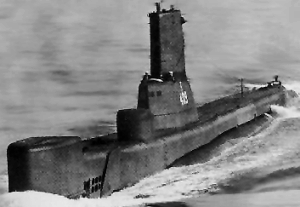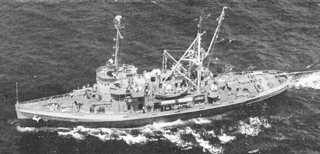
USS Sam Houston (SSBN-609/SSN-609), an Ethan Allen-class submarine, was the second ship of the United States Navy to be named after Sam Houston (1793–1863), president of the Republic of Texas. Sam Houston was the US Navy's seventh ballistic missile submarine.

USS Archerfish (SSN-678), a Sturgeon-class attack submarine, was the second ship of the United States Navy to be named for the archerfish, a family (Toxotidae) of fish notable for their habit of preying on insects and other animals by shooting them down with squirts of water from the mouth.

USS Tullibee (SSN-597), a unique submarine, was the second ship of the United States Navy to be named for the tullibee, any of several whitefishes of central and northern North America.

USS Shark (SSN-591), a Skipjack-class submarine, was the seventh ship of the United States Navy to be named for the shark.

USS Tinosa (SSN-606), a Permit-class submarine, was the second ship of the United States Navy to be named for the tinosa, a poisonous, black, tropical fish.

USS Whale (SSN-638) was a Sturgeon-class submarine nuclear-powered attack submarine of the United States Navy. She was the second ship of that name, after the whale family of aquatic mammals.

USS Bergall (SSN-667), a Sturgeon-class attack submarine, was the second ship of the United States Navy to be named for the bergall, a small fish found along the Atlantic coast of North America from the Chesapeake Bay to Labrador.

USS Trepang (SSN-674), a Sturgeon-class attack submarine, was the second ship of the United States Navy to be named for the trepang, Holothuroidea, a marine animal with a long, tough, muscular body.

USS Ray (SSN-653), a Sturgeon-class attack submarine, was the second ship of the United States Navy to be named for the rays.

USS Sea Leopard (SS-483), a Tench-class submarine, was the only ship of the United States Navy to be named for the leopard seal. Her keel was laid down by the Portsmouth Navy Yard on 7 November 1944. She was launched on 2 March 1945 sponsored by Hon. Margaret Chase Smith, United States Congresswoman from Maine, and commissioned on 11 June 1945.

USS Tusk (SS-426), a Balao-class submarine, was the only ship of the United States Navy to be named for the tusk, an alternate name for the cusk, a large edible saltwater fish related to the cod. Her keel was laid down on 23 August 1943 at Philadelphia by the Cramp Shipbuilding Company. She was launched on 8 July 1945 sponsored by Mrs. Carolyn Park Mills, and commissioned on 11 April 1946.

USS Sea Owl (SS/AGSS-405), a Balao-class submarine, was a ship of the United States Navy named for the sea owl, a lumpfish of the North Atlantic Ocean.

USS Sea Robin (SS-407), a Balao-class submarine, was a vessel of the United States Navy named for the sea robin. This is a spiny-finned fish with red or brown coloring on its body and fins. The first three rays of its pectoral fin separate from the others and are used in walking on the sea bottom.

USS Piper (SS/AGSS-409), a Balao-class submarine, was a ship of the United States Navy named after the piper. Although built late in World War II, Piper completed three successful war patrols before the cessation of hostilities, operating as a life guard for plane strikes and as an advance picket for fast carrier task forces.
USS Skylark may refer to the following ships of the United States Navy:

The third USS Penguin (ASR–12) was a submarine rescue ship in the United States Navy during World War II. She was the lead ship of a class of three vessels all originally laid down as fleet ocean tugs before being converted to rescue ships before completion.

USS Kittiwake (ASR-13) was a United States Navy Chanticleer-class submarine rescue vessel in commission from 1946 to 1994.

The fifth USS Petrel (ASR-14) was a Chanticleer-class submarine rescue ship in the United States Navy.

USS Sunbird (ASR-15) was a Chanticleer-class submarine rescue ship in the United States Navy.

USS Tringa (ASR-16) was a Chanticleer-class submarine rescue ship of the United States Navy. She was laid down on 12 July 1945 at Savannah, Georgia, by the Savannah Machine & Foundry Co.; launched on 25 June 1946; sponsored by Mrs. Nola Dora Vassar, the mother of Curtis L. Vassar, Jr., missing in action; and commissioned on 28 January 1947.




















